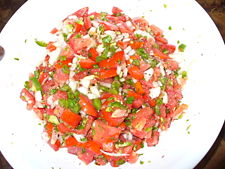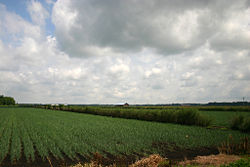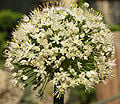Difference between revisions of "Onion" - New World Encyclopedia
(Fixed) |
(Applied Category tags, checked spelling, applied Ready tag.) |
||
| Line 1: | Line 1: | ||
| − | {{Claimed}}{{Contracted}} | + | {{Claimed}}{{Contracted}}{{Ready}} |
{{otheruses}} | {{otheruses}} | ||
{{Taxobox | {{Taxobox | ||
| Line 20: | Line 20: | ||
== Origin and distribution == | == Origin and distribution == | ||
| − | ''Allium cepa'' is known only in cultivation, but related wild species occur in Central Asia. The most closely-related species include ''Allium vavilovii'' Popov & Vved. and ''Allium asarense'' R.M. Fritsch & Matin from Iran.<ref name="prota">Grubben, G.J.H. & | + | ''Allium cepa'' is known only in cultivation, but related wild species occur in Central Asia. The most closely-related species include ''Allium vavilovii'' Popov & Vved. and ''Allium asarense'' R.M. Fritsch & Matin from Iran.<ref name="prota">Grubben, G.J.H. & O.A. Denton. 2004. ''Plant Resources of Tropical Africa 2, Vegetables''. PROTA Foundation. Leiden, NL: Backhuys. ISBN 9057821486.</ref> However Zohary and Hopf warn that "there are doubts whether the ''vavilovii'' collections tested represent genuine wild material or only feral derivatives of the crop."<ref>Zohary, Daniel and Maria Hopf. 2000. ''Domestication of plants in the Old World''. Oxford, UK: Oxford University Press. ISBN 0198503571.</ref> |
| − | |||
| − | |||
| − | |||
== Uses == | == Uses == | ||
| Line 35: | Line 32: | ||
== Historical uses == | == Historical uses == | ||
[[Image:Muck onions 8640.jpg|250px|right|thumb|Onion fields near [[Elba, New York]]]] | [[Image:Muck onions 8640.jpg|250px|right|thumb|Onion fields near [[Elba, New York]]]] | ||
| − | It is thought that bulbs from the onion family have been used as a food source for millennia. In Caananite [[Bronze Age]] settlements, traces of onion remains were found alongside [[fig]] and [[date palm|date]] stones dating back to 5000 B.C.E.{{Fact|date=August 2007}} However, it is not clear if these were cultivated onions. Archaeological and literary evidence suggests cultivation probably took place around two thousand years later in [[ancient Egypt]], at the same time that [[Leek (vegetable)|leek]]s and [[garlic]] were cultivated. Workers who built the Egyptian pyramids may have been fed [[radish]]es and onions.<ref> | + | It is thought that bulbs from the onion family have been used as a food source for millennia. In Caananite [[Bronze Age]] settlements, traces of onion remains were found alongside [[fig]] and [[date palm|date]] stones dating back to 5000 B.C.E.{{Fact|date=August 2007}} However, it is not clear if these were cultivated onions. Archaeological and literary evidence suggests cultivation probably took place around two thousand years later in [[ancient Egypt]], at the same time that [[Leek (vegetable)|leek]]s and [[garlic]] were cultivated. Workers who built the Egyptian pyramids may have been fed [[radish]]es and onions.<ref>[http://www.selfsufficientish.com/onion.htm Onions Allium cepa]. selfsufficientish.com. Retrieved November 11, 2007.</ref> |
| − | |||
| − | |||
| − | |||
| − | |||
| − | </ref> | ||
The onion is easily propagated, transported and stored. [[Egypt]]ians worshipped it, believing that its spherical shape and concentric rings symbolized eternal life. Onions were even used in Egyptian burials as evidenced by onion traces being found in the eye sockets of [[Ramesses IV]]. They believed that if buried with the dead, the strong scent of onions would bring breath back to the dead. | The onion is easily propagated, transported and stored. [[Egypt]]ians worshipped it, believing that its spherical shape and concentric rings symbolized eternal life. Onions were even used in Egyptian burials as evidenced by onion traces being found in the eye sockets of [[Ramesses IV]]. They believed that if buried with the dead, the strong scent of onions would bring breath back to the dead. | ||
| Line 49: | Line 41: | ||
{{nutritionalvalue | name = Raw Onions | kJ=166 | carbs = 9.34 g | protein=1.1 g | fat= 0.1 g | satfat=0.042 g | monofat = 0.013 g | polyfat = 0.017 g | sugars=4.24 g | fiber = 1.7 g | thiamin_mg=0.046 | riboflavin_mg=0.027 | niacin_mg=0.116 | folate_ug=19 | vitA_ug = 0 | vitB6_mg=0.12 | vitB12_ug=0 | vitC_mg=7.4 | vitE_mg=0.02 | vitK_ug=0.4 | calcium_mg=23 | iron_mg=0.21 | magnesium_mg=0.129 | phosphorus_mg=29 | potassium_mg=146 | sodium_mg=4 | zinc_mg=0.17 | water=89.11 g | source_usda=1 | right=1}} | {{nutritionalvalue | name = Raw Onions | kJ=166 | carbs = 9.34 g | protein=1.1 g | fat= 0.1 g | satfat=0.042 g | monofat = 0.013 g | polyfat = 0.017 g | sugars=4.24 g | fiber = 1.7 g | thiamin_mg=0.046 | riboflavin_mg=0.027 | niacin_mg=0.116 | folate_ug=19 | vitA_ug = 0 | vitB6_mg=0.12 | vitB12_ug=0 | vitC_mg=7.4 | vitE_mg=0.02 | vitK_ug=0.4 | calcium_mg=23 | iron_mg=0.21 | magnesium_mg=0.129 | phosphorus_mg=29 | potassium_mg=146 | sodium_mg=4 | zinc_mg=0.17 | water=89.11 g | source_usda=1 | right=1}} | ||
| − | Evidence suggests that onions may be effective against the common cold, heart disease, [[diabetes]], [[osteoporosis]], and other diseases. They contain [[anti-inflammatory]], anticholesterol, anticancer, and [[antioxidant]] components such as [[quercetin]].<ref>[http://www.whfoods.com/genpage.php?tname=foodspice&dbid=45 World's Healthiest Foods | + | Evidence suggests that onions may be effective against the common cold, heart disease, [[diabetes]], [[osteoporosis]], and other diseases. They contain [[anti-inflammatory]], anticholesterol, anticancer, and [[antioxidant]] components such as [[quercetin]].<ref>[http://www.whfoods.com/genpage.php?tname=foodspice&dbid=45 Onions]. World's Healthiest Foods. Retrieved November 11, 2007.</ref> |
In many parts of the world, onions are used to heal blisters and [[boils]]. A traditional [[Maltese]] remedy for [[sea urchin]] wounds is to tie half a baked onion to the afflicted area overnight. In the morning, the spikes will be in the onion.{{Fact|date=August 2007}} In the [[United States]], products that contain onion extract (such as [[Mederma]]) are used in the treatment of topical scars.{{Fact|date=August 2007}} | In many parts of the world, onions are used to heal blisters and [[boils]]. A traditional [[Maltese]] remedy for [[sea urchin]] wounds is to tie half a baked onion to the afflicted area overnight. In the morning, the spikes will be in the onion.{{Fact|date=August 2007}} In the [[United States]], products that contain onion extract (such as [[Mederma]]) are used in the treatment of topical scars.{{Fact|date=August 2007}} | ||
| − | In [[homeopathy]], Allium cepa is used for rhinorrhea and hay fever.<ref> | + | In [[homeopathy]], Allium cepa is used for rhinorrhea and hay fever.<ref>Morrsion, Roger. 1993. ''Desktop guide to keynotes and confirmatory symptoms''. Grass Valley, CA: Hahnemann Clinic Publishing. ISBN 0-9635368-0-X.</ref> |
| − | |||
| − | |||
| − | |||
| − | |||
| − | |||
| − | |||
| − | |||
| − | </ref> | ||
Onions, like [[garlic]], are members of the [[Allium]] family, and both are rich in powerful sulfur-containing compounds that are responsible for their pungent odors and for many of their health-promoting effects. Onions contain allyl propyl disulphide, while garlic is rich in allicin, diallyl disulphide, diallyl trisulfide and others. In addition, onions are very rich in chromium, a trace mineral that helps cells respond to insulin, plus vitamin C, and numerous flavonoids, most notably, [[quercetin]]. | Onions, like [[garlic]], are members of the [[Allium]] family, and both are rich in powerful sulfur-containing compounds that are responsible for their pungent odors and for many of their health-promoting effects. Onions contain allyl propyl disulphide, while garlic is rich in allicin, diallyl disulphide, diallyl trisulfide and others. In addition, onions are very rich in chromium, a trace mineral that helps cells respond to insulin, plus vitamin C, and numerous flavonoids, most notably, [[quercetin]]. | ||
| Line 81: | Line 65: | ||
== Onions and eye irritation == | == Onions and eye irritation == | ||
| − | As onions are sliced, [[cell (biology)|cells]] are broken, allowing [[enzymes]] called [[alliinase]]s to break down [[sulfides]] and generate [[sulfenic acid]]s ([[amino acid]] [[sulfoxide]]s). Sulphenic acids are unstable and decompose into a volatile [[gas]] called [[syn-propanethial-S-oxide]]. The gas diffuses through the air and eventually reaches the eye, where it reacts with the water to form a diluted solution of [[sulfuric acid]]. This acid irritates the [[nerve]] endings in the [[eye]], making them sting. Tear glands produce tears to dilute and flush out the irritant.<ref name="Sciam"> | + | As onions are sliced, [[cell (biology)|cells]] are broken, allowing [[enzymes]] called [[alliinase]]s to break down [[sulfides]] and generate [[sulfenic acid]]s ([[amino acid]] [[sulfoxide]]s). Sulphenic acids are unstable and decompose into a volatile [[gas]] called [[syn-propanethial-S-oxide]]. The gas diffuses through the air and eventually reaches the eye, where it reacts with the water to form a diluted solution of [[sulfuric acid]]. This acid irritates the [[nerve]] endings in the [[eye]], making them sting. Tear glands produce tears to dilute and flush out the irritant.<ref name="Sciam">Scott, Thomas. [http://www.sciam.com/askexpert_question.cfm?articleID=000C5FF7-5DB5-1C72-9EB7809EC588F2D7 What is the chemical process that causes my eyes to tear when I peel an onion?] Scientific American. Retrieved November 11, 2007.</ref> |
| − | |||
| − | |||
| − | |||
| − | |||
| − | |||
| − | |||
| − | |||
| − | |||
| − | |||
| − | |||
| − | |||
| − | |||
| − | </ref> | ||
| − | Supplying ample water to the reaction prevents the gas from reaching the eyes. Eye irritation can, therefore, be avoided by cutting onions under running water or submerged in a basin of water. Rinsing the onion and leaving it wet while chopping may also be effective. Another way to avoid irritation is by not cutting off the root of the onion, or by doing it last, as the root of the onion has a higher concentration of enzymes.<ref>[http://www.onions-usa.org/about/faq.asp#cooking Onions-USA.org | + | Supplying ample water to the reaction prevents the gas from reaching the eyes. Eye irritation can, therefore, be avoided by cutting onions under running water or submerged in a basin of water. Rinsing the onion and leaving it wet while chopping may also be effective. Another way to avoid irritation is by not cutting off the root of the onion, or by doing it last, as the root of the onion has a higher concentration of enzymes.<ref>[http://www.onions-usa.org/about/faq.asp#cooking FAQ]. Onions-USA.org. Retrieved November 11, 2007.</ref> Chilling or freezing onions prevents the enzymes from activating, limiting the amount of gas generated. Using a sharp blade to chop onions will limit the cell damage and the release of enzymes that drive the irritation response. Having a fire, such as a candle or a burner, will help as the heat and flames will draw in the onion gas, burn it, and then send it up with the rest of the flame exhaust. In the heat, the chemical changes such that it no longer irritates the eyes. |
The volume of sulphenic acids released, and the irritation effect, differs among ''Allium'' species. | The volume of sulphenic acids released, and the irritation effect, differs among ''Allium'' species. | ||
| Line 158: | Line 129: | ||
|'''World Total''' || align="right" | '''64,101''' | |'''World Total''' || align="right" | '''64,101''' | ||
|- | |- | ||
| − | |colspan=2|''Source: <br/>[[UN Food & Agriculture | + | |colspan=2|''Source: <br/>[[UN Food & Agriculture Organization]] (FAO)''[http://faostat.fao.org/site/340/default.aspx] |
|} | |} | ||
{{clear}} | {{clear}} | ||
| Line 173: | Line 144: | ||
In other languages too the onion has acquired different connotations, eg., amongst the Khasi tribe in North East India, Onion or "piat" in the local dialect refers to someone who is present everywhere or in every social gathering. | In other languages too the onion has acquired different connotations, eg., amongst the Khasi tribe in North East India, Onion or "piat" in the local dialect refers to someone who is present everywhere or in every social gathering. | ||
| − | |||
| − | |||
| − | |||
| − | |||
| − | |||
| − | |||
| − | |||
== See also == | == See also == | ||
| Line 185: | Line 149: | ||
*[[Vidalia onion]] | *[[Vidalia onion]] | ||
| − | [[Category: | + | ==Notes== |
| − | [[Category: | + | <references/> |
| + | |||
| + | == External links == | ||
| + | *[http://database.prota.org/dbtw-wpd/exec/dbtwpub.dll?AC=QBE_QUERY&BU=http%3A%2F%2Fdatabase.prota.org%2Fsearch.htm&TN=PROTAB~1&QB0=AND&QF0=Species+Code&QI0=Allium+cepa&RF=Webdisplay PROTAbase on ''Allium cepa'']. Retrieved November 11, 2007. | ||
| + | *Fry, Steve. [http://members.aol.com/stevef88/discuss/onions.htm The Secret to Cutting Onions Without Crying]. Retrieved November 11, 2007. | ||
| + | |||
| + | [[Category:Life sciences]] | ||
| + | [[Category:Plants]] | ||
{{Credit|170294629}} | {{Credit|170294629}} | ||
Revision as of 06:43, 11 November 2007
- For other uses, see Onion (disambiguation).
| Onion | ||||||||||||||
|---|---|---|---|---|---|---|---|---|---|---|---|---|---|---|
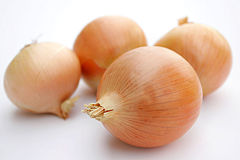 Onions
| ||||||||||||||
| Scientific classification | ||||||||||||||
| ||||||||||||||
| Allium cepa L. |
Many plants in the genus Allium are known by the common name onion but, used without qualifiers, it usually refers to Allium cepa. Allium cepa is also known as the 'garden onion' or 'bulb' onion and 'shallot'.
Origin and distribution
Allium cepa is known only in cultivation, but related wild species occur in Central Asia. The most closely-related species include Allium vavilovii Popov & Vved. and Allium asarense R.M. Fritsch & Matin from Iran.[1] However Zohary and Hopf warn that "there are doubts whether the vavilovii collections tested represent genuine wild material or only feral derivatives of the crop."[2]
Uses
Onions are available in fresh, frozen, canned, pickled, and dehydrated forms. Onions can be used, usually chopped or sliced, in almost every type of food, including cooked foods and fresh salads, and as a spicy garnish; they are rarely eaten on their own but usually act as accompaniment to the main course. Depending on the variety, an onion can be sharp, spicy, and pungent or mild and sweet.
Onions pickled in vinegar are eaten as a snack. These are often served as a side serving in fish and chip shops throughout the United Kingdom. Onions are a staple food in India, and are therefore fundamental to Indian cooking. They are commonly used as a base for curries, or made into a paste and eaten as a main course or as a side dish.
Tissue from onions is frequently used in science education to demonstrate microscope usage, because they have particularly large cells which are readily observed even at low magnifications.[citation needed]
Historical uses
It is thought that bulbs from the onion family have been used as a food source for millennia. In Caananite Bronze Age settlements, traces of onion remains were found alongside fig and date stones dating back to 5000 B.C.E.[citation needed] However, it is not clear if these were cultivated onions. Archaeological and literary evidence suggests cultivation probably took place around two thousand years later in ancient Egypt, at the same time that leeks and garlic were cultivated. Workers who built the Egyptian pyramids may have been fed radishes and onions.[3]
The onion is easily propagated, transported and stored. Egyptians worshipped it, believing that its spherical shape and concentric rings symbolized eternal life. Onions were even used in Egyptian burials as evidenced by onion traces being found in the eye sockets of Ramesses IV. They believed that if buried with the dead, the strong scent of onions would bring breath back to the dead.
In ancient Greece, athletes ate large quantities of onion because it was believed that it would lighten the balance of blood. Roman gladiators were rubbed down with onion to firm up their muscles. In the Middle Ages onions were such an important food that people would pay for their rent with onions and even give them as gifts.[citation needed] Doctors were known to prescribe onions to relieve headaches, snakebite and hair loss. The onion was introduced to North America by Christopher Columbus on his 1492 expedition to Haiti. Onions were also prescribed by doctors in the early 1500s to help with infertility in women, and even dogs and cattle and many other household pets.
Medicinal properties and health benefits
| Raw Onions Nutritional value per 100 g | |||||||||||||||||||||||||||||||||||||||||||||||
|---|---|---|---|---|---|---|---|---|---|---|---|---|---|---|---|---|---|---|---|---|---|---|---|---|---|---|---|---|---|---|---|---|---|---|---|---|---|---|---|---|---|---|---|---|---|---|---|
| Energy 40 kcal 170 kJ | |||||||||||||||||||||||||||||||||||||||||||||||
| |||||||||||||||||||||||||||||||||||||||||||||||
| Percentages are relative to US recommendations for adults. Source: USDA Nutrient database | |||||||||||||||||||||||||||||||||||||||||||||||
Evidence suggests that onions may be effective against the common cold, heart disease, diabetes, osteoporosis, and other diseases. They contain anti-inflammatory, anticholesterol, anticancer, and antioxidant components such as quercetin.[4]
In many parts of the world, onions are used to heal blisters and boils. A traditional Maltese remedy for sea urchin wounds is to tie half a baked onion to the afflicted area overnight. In the morning, the spikes will be in the onion.[citation needed] In the United States, products that contain onion extract (such as Mederma) are used in the treatment of topical scars.[citation needed]
In homeopathy, Allium cepa is used for rhinorrhea and hay fever.[5]
Onions, like garlic, are members of the Allium family, and both are rich in powerful sulfur-containing compounds that are responsible for their pungent odors and for many of their health-promoting effects. Onions contain allyl propyl disulphide, while garlic is rich in allicin, diallyl disulphide, diallyl trisulfide and others. In addition, onions are very rich in chromium, a trace mineral that helps cells respond to insulin, plus vitamin C, and numerous flavonoids, most notably, quercetin.
The higher the intake of onion, the lower the level of glucose found during oral or intravenous glucose tolerance tests. Experimental and clinical evidence suggests that allyl propyl disulfide is responsible for this effect and lowers blood sugar levels by increasing the amount of free insulin available. Allyl propyl disulfide does this by competing with insulin, which is also a disulphide, to occupy the sites in the liver where insulin is inactivated. This results is an increase in the amount of insulin available to usher glucose into cells causing a lowering of blood sugar.
In addition, onions are a very good source of chromium, the mineral component in glucose tolerance factor, a molecule that helps cells respond appropriately to insulin. Clinical studies of diabetics have shown that chromium can decrease fasting blood glucose levels, improve glucose tolerance, lower insulin levels, and decrease total cholesterol and triglyceride levels, while increasing HDL-cholesterol levels. Marginal chromium deficiency is common in the United States, not surprising since chromium levels are depleted by the consumption of refined sugars and white flour products as well as the lack of exercise. One cup of raw onion contains over 20% of the Daily Value for this important trace mineral.
The regular consumption of onions has, like garlic, been shown to lower high cholesterol levels and high blood pressure, both of which help prevent atherosclerosis and diabetic heart disease, and reduce the risk of heart attack or stroke. These beneficial effects are likely due to onions' sulfur compounds, its chromium and its vitamin B6, which helps prevent heart disease by lowering high homocysteine levels, another significant risk factor for heart attack and stroke. Onions have been singled out as one of the small number of vegetables and fruits that contributed to the significant reduction in heart disease risk seen in a meta-analysis of seven prospective studies. Of the more than 100,000 individuals who participated in these studies, those who diets most frequently included onions, tea, apples and broccoli-the richest sources of flavonoids-gained a 20% reduction in their risk of heart disease.
Quercetin, an antioxidant in onions, and curcumin, a phytonutrient found in the curry spice turmeric, reduce both the size and number of precancerous lesions in the human intestinal tract, suggests research published in Clinical Gasteroenterology and Hepatology.
A compound newly identified in onions called gamma-L-glutamyl-trans-S-1-propenyl-L-cysteine sulfoxide (GPCS) inhibits the activity of osteoclasts (the cells that break down bone). The more GPCS given in this animal study, the more the bone resorptive (breakdown) action of osteoclasts was inhibited.
Onions may be especially beneficial for women,[citation needed] who are at increased risk for osteoporosis as they go through menopause. Fosamax (Alendronate), the drug typically prescribed to prevent excessive bone loss, works in a similar manner, by destroying osteoclasts, so they do not break down bone. Potential negative side effects of Fosamax include irritation of the upper gastrointestinal mucosa, acid regurgitation, esophageal ulcers and erosions.
Several anti-inflammatory agents in onions render them helpful in reducing the severity of symptoms associated with inflammatory conditions such as the pain and swelling of osteo- and rheumatoid arthritis, the allergic inflammatory response of asthma, and the respiratory congestion associated with the common cold. Both onions and garlic contain compounds that inhibit lipoxygenase and cyclooxygenase (the enzymes that generate inflammatory prostaglandins and thromboxanes), thus markedly reducing inflammation. Onions' anti-inflammatory effects are due not only to their vitamin C and quercetin, but to other active components called isothiocyanates. These compounds work synergistically to provide relief from inflammation. In addition, quercetin and other flavonoids found in onions work with vitamin C to help kill harmful bacteria, making onions an especially good addition to soups and stews during cold and flu season.
Onions and eye irritation
As onions are sliced, cells are broken, allowing enzymes called alliinases to break down sulfides and generate sulfenic acids (amino acid sulfoxides). Sulphenic acids are unstable and decompose into a volatile gas called syn-propanethial-S-oxide. The gas diffuses through the air and eventually reaches the eye, where it reacts with the water to form a diluted solution of sulfuric acid. This acid irritates the nerve endings in the eye, making them sting. Tear glands produce tears to dilute and flush out the irritant.[6]
Supplying ample water to the reaction prevents the gas from reaching the eyes. Eye irritation can, therefore, be avoided by cutting onions under running water or submerged in a basin of water. Rinsing the onion and leaving it wet while chopping may also be effective. Another way to avoid irritation is by not cutting off the root of the onion, or by doing it last, as the root of the onion has a higher concentration of enzymes.[7] Chilling or freezing onions prevents the enzymes from activating, limiting the amount of gas generated. Using a sharp blade to chop onions will limit the cell damage and the release of enzymes that drive the irritation response. Having a fire, such as a candle or a burner, will help as the heat and flames will draw in the onion gas, burn it, and then send it up with the rest of the flame exhaust. In the heat, the chemical changes such that it no longer irritates the eyes.
The volume of sulphenic acids released, and the irritation effect, differs among Allium species.
A firm in Toronto, Canada, attempted to utilize this property of onions in the manufacture of a form of tear gas for civilian use. It was marketed in 1991 but was unsuccessful as it had an effective shelf life of only three months.[citation needed]
Propagation
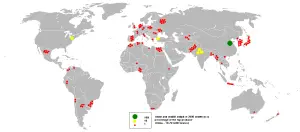
Onions may be grown from seed or, most commonly, from sets. Onion sets are produced by sowing seed very thickly one year, resulting in stunted plants which produce very small bulbs. These bulbs are very easy to set out and grow into mature bulbs the following year, but they have the reputation of producing a less durable bulb than onions grown directly from seed and thinned.
Either planting method may be used to produce spring onions or green onions, which are onions harvested while immature. Green onion is a name also used to refer to Allium fistulosum, the Welsh onion, which is said not to produce dry bulbs.
Varieties
- Bulb onion - Grown from seed (or onion sets), bulb onions range from the pungent varieties used for dried soups and onion powder to the mild and hearty sweet onions, such as the Vidalia from Georgia or Walla Walla from Washington that can be sliced and eaten on a sandwich instead of meat.
- Multiplier onions - Raised from bulbs which produce multiple shoots, each of which forms a bulb.
- Potato onion
- Tree onion or Egyptian onion - Produce bulblets in the flower head; a hybrid of Allium cepas.
Shallots and ten other onion (Allium cepa L.) varieties commonly available in the United States were evaluated: Western Yellow, Northern Red, New York Bold, Western White, Peruvian Sweet, Empire Sweet, Mexico, Texas 1015, Imperial Valley Sweet, and Vidalia.
In general, the most pungent onions delivered many times the benefits of their milder cousins.
Shallots had the most phenols, six times the amount found in Vidalia onion, the variety with the lowest phenolic content. Shallots also had the most antioxidant activity, followed by Western Yellow, New York Bold, Northern Red, Mexico, Empire Sweet, Western White, Peruvian Sweet, Texas 1015, Imperial Valley Sweet, and Vidalia.
Western Yellow onions had the most flavonoids, eleven times the amount found in Western White, the variety with the lowest flavonoid content.
For all varieties of onions, the more phenols and flavonoids they contained, the more antioxidant and anti-cancer activity they provided.
When tested against liver and colon cancer cells, Western Yellow, New York Bold and shallots were most effective in inhibiting their growth. The milder-tasting varieties, Western White, Peruvian Sweet, Empire Sweet, Mexico, Texas 1015, Imperial Valley Sweet, and Vidalia, showed little cancer-fighting ability.
Production trends
| Top Ten Onions Producers—2005 (1000 tonnes) | |
|---|---|
| 19,793 | |
| 5,500 | |
| 3,346 | |
| 2,220 | |
| 1,764 | |
| 1,758 | |
| 1,750 | |
| 1,637 | |
| 1,302 | |
| 1,149 | |
| World Total | 64,101 |
| Source: UN Food & Agriculture Organization (FAO)[1] | |
Onions in language
In the English vernacular, "an onion" is a difficult situation, the use stemming from the onion's tendency to irritate or inflame the eyes.[citation needed] Conversely, the term "onion" can be used to describe any state of being, as in the phrase, "[someone] really dices my onion!" It may also represent an object of many layers.
In some Scots dialects, onion is pronounced 'Ingin'.
The expression "Layers of the onion" is used to describe a situation in which it is possible to go deeper and deeper revealing seemingly similar layers until a central core is reached. It has been used as a metaphor in mysticism to describe the supposed layers of reality. More recently, the phrase "Onions have layers, Ogres have layers!" is said by the character Shrek in the first Shrek movie, by Dreamworks LLC, when he tries to explain to his partner, Donkey, that he is a complex person.
In other languages too the onion has acquired different connotations, eg., amongst the Khasi tribe in North East India, Onion or "piat" in the local dialect refers to someone who is present everywhere or in every social gathering.
See also
- Onion Johnny
- Vidalia onion
Notes
- ↑ Grubben, G.J.H. & O.A. Denton. 2004. Plant Resources of Tropical Africa 2, Vegetables. PROTA Foundation. Leiden, NL: Backhuys. ISBN 9057821486.
- ↑ Zohary, Daniel and Maria Hopf. 2000. Domestication of plants in the Old World. Oxford, UK: Oxford University Press. ISBN 0198503571.
- ↑ Onions Allium cepa. selfsufficientish.com. Retrieved November 11, 2007.
- ↑ Onions. World's Healthiest Foods. Retrieved November 11, 2007.
- ↑ Morrsion, Roger. 1993. Desktop guide to keynotes and confirmatory symptoms. Grass Valley, CA: Hahnemann Clinic Publishing. ISBN 0-9635368-0-X.
- ↑ Scott, Thomas. What is the chemical process that causes my eyes to tear when I peel an onion? Scientific American. Retrieved November 11, 2007.
- ↑ FAQ. Onions-USA.org. Retrieved November 11, 2007.
External links
- PROTAbase on Allium cepa. Retrieved November 11, 2007.
- Fry, Steve. The Secret to Cutting Onions Without Crying. Retrieved November 11, 2007.
Credits
New World Encyclopedia writers and editors rewrote and completed the Wikipedia article in accordance with New World Encyclopedia standards. This article abides by terms of the Creative Commons CC-by-sa 3.0 License (CC-by-sa), which may be used and disseminated with proper attribution. Credit is due under the terms of this license that can reference both the New World Encyclopedia contributors and the selfless volunteer contributors of the Wikimedia Foundation. To cite this article click here for a list of acceptable citing formats.The history of earlier contributions by wikipedians is accessible to researchers here:
The history of this article since it was imported to New World Encyclopedia:
Note: Some restrictions may apply to use of individual images which are separately licensed.
